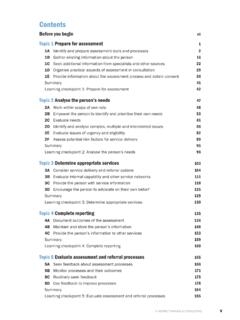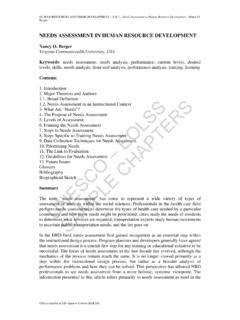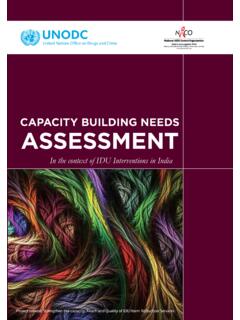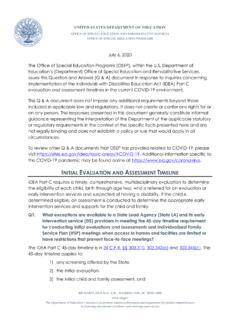Transcription of Conducting a Needs Assessment - Centers for Disease ...
1 Conducting a Needs Assessment A Needs Assessment can be a valuable tool for identifying the training, activities, and resources needed by your organization in preparing for the transition from ICD-9-CM to ICD-10-CM/PCS. Assessment results can improve prioritization of an organization's often limited transition resources. The below sample Needs Assessment was utilized by the CDC ICD-10 Transition Workgroup to identify common Needs and gaps across the CDC. Impacted public health organizations are encouraged to tailor the content and questions in development of their own ICD-10 transition Needs Assessment . Sample Needs Assessment Suggested background information The Department of Health & Human Services has mandated a transition by the health care industry from the International Classification of Diseases (ICD) ninth revision ICD-9-CM (contains diagnosis and procedure codes) to ICD-10-CM (diagnoses).
2 And ICD-10-PCS (procedures) code sets on October 1, 2014 for morbidity data. [insert organization] is Conducting a Needs Assessment to ascertain program readiness status for the upcoming migration from ICD-9 to ICD-10-CM and ICD-10-PCS. For more information on the transition you can visit CDC's website: This Needs Assessment serves four purposes: 1. To identify common Needs and gaps across [insert organization] that could potentially be addressed by shared solutions, 2. To leverage the use of existing processes and tools to optimize efficiency in resource usage, 3. To document successes and challenges that programs have already faced in their planning efforts to facilitate the sharing of lessons learned, and 4. To help programs begin self-assessing their status in regards to planning for this transition. Suggested completion instructions Please complete this Needs Assessment if you believe that your program might be impacted by this transition.
3 Please answer the following questions for each of the systems* for which you are the designated contact person. (* A system can be any tool, application, or data store, or any activity carried out in your program that uses ICD-9-CM codes. For example, a database that contains diagnosis codes sent by a state health department would need to be modified to accept ICD-10-CM codes). Completing this Needs Assessment should take approximately 15 minutes. Suggested questionnaire Background 1. First name: Last name: 2. Your role: 3. Organizational Information: a. C/I/O: b. Division / Office: c. Branch (if applicable): d. Program (if applicable): 4. How did you learn of this mandated transition: a. Health and Human Services (please specify): b. Centers for Medicare and Medicaid Services c. National Cancer Institute d. CDC ICD-10 Transition Workgroup e.
4 Centers for Disease Control and Prevention f. Other (please specify): 5. Name or describe all the systems, applications, tools, etc. for which you are answering this survey a. What types of ICD-9-CM codes does your system use? (please check all that apply). o Diagnosis/ external cause of injury codes in ICD-9-CM. o Procedure codes in ICD-9-CM Volume 3. o Other Please describe b. How long has your program been using ICD-9-CM coded data? (years). c. Please explain how your program uses ICD-9-CM coded data. Please describe d. Have you already been converting ICD-9-CM to ICD-10? Yes No 6. Has your program considered the impact of the upcoming transition on your system? Yes Please describe what steps you have taken ( informal discussions, meetings, formal evaluation of impact, etc.). No Planning 7. What planning steps have you taken to prepare for this transition?
5 Some None Please describe the steps you have taken. a. On a scale of 1 to 100% complete, how far along are you in the transition planning process for your systems? <25%. 25-50%. 51-75%. >75%. b. Do you know what your 1st steps should be in order to begin planning for this transition? Yes No c. What are the barriers you face in beginning to plan for this transition? Please describe Implementation of Transition Plan 8. What steps have you taken to implement your transition plan? Some None Please specify a. On a scale of 1 to 100% complete, how far along are you in the implementation process for your systems? <25%. 25-50%. 51-75%. >75%. Don't know Needs 9. Please tell us if your program has sufficient capacity to manage this transition in the following areas: Area Leadership engagement Yes No Don't Know N/A. Subject matter expertise Yes No Don't Know N/A.
6 Technological expertise (IT support). Yes No Don't Know N/A. Financial resources Yes No Don't Know N/A. Staff Yes No Don't Know N/A. Training Yes No Don't Know N/A. Other Yes No Please Describe Other Yes No Please Describe Other Yes No Please Describe Other Yes No Please Describe 10. Can you identify general or specific Needs that you will have during this transition? (please check or describe all that apply). Leadership engagement: Please describe Trend analyses (analyzing data over time that include ICD-9-CM and ICD-10 code sets). Loss of information (elimination of previously used code/s). Data aggregation Knowledge of current definitions Data collection Subject matter expertise: Re-writing or writing new programs Redesign of publications and tables Knowledge of implementing / leveraging General Equivalence Maps (GEMs).
7 Detailed knowledge of ICD morbidity classification Project Management Other Please describe Redesign to accommodate alphanumeric codes, 7 character codes, code title lengths Messaging volume Technological expertise / IT. or data processing: System logic & edits System storage capacity New computer edits Testing/validating systems use of new code sets Update/modify system documentation Other Please describe Financial resources: Please describe Staff: Please describe Primary users (medical coders, either contractors / FTE). If checked, please try to estimate the number of staff that might need training. Secondary users (epidemiologists; statisticians; IT personnel; programmers, end users and consumers of the data). If checked, please try to estimate the number of staff that might need Training for: training. Project Managers.
8 If checked, please try to estimate the number of staff that might need training. Other. Please describe If "Other" is checked, please try to estimate the number of staff that might need training. General ICD-9-CM volume 3 to ICD-10-PCS Transition Business practices/workflow General Equivalence Maps (GEMs). Training on: Coding of specific ICD-10-CM Chapters Please describe Coding of specific ICD-10-PCS Chapters Please describe Other Please describe Use of ICD-9-CM Coded Data 11. What vendors or partners are working with your program regarding the use of ICD-9-CM coded data after the upcoming transition? Please describe. Documenting Lessons Learned This section is to document successes and challenges that your program has already faced in your planning efforts so that other programs can benefit as well. Please answer the following questions keeping in mind that this information may be used by other programs to replicate your program's transition steps, or to avoid the difficulties that your program encountered.
9 12. Were any of the planning steps you have taken particularly successful that you might recommend to other programs planning for this transition? Please describe 13. Were there any situations that your program encountered that you could have avoided if you had used another approach? Please describe both the scenario and any recommended alternate pathways. Please describe 14. In your efforts to prepare for the transition to ICD-10-CM and/or ICD-10-PCS codes, have you developed or used any tools or frameworks ( , crosswalks from ICD-9-CM to ICD-10-CM for a code set of diseases, conditions, injuries, external causes of injury, symptoms, or procedures) to assist you in the transition? Yes Please describe No 15. Are you willing to share this tool or framework with others that may be interested? Yes No If yes, [insert contact info] will contact you.
10 16. Would you be interested in participating in any future forums to share experiences or lessons learned with other CDC. offices or federal Operating Divisions? Yes No 17. Do you have any additional comments or questions to meet the objectives of this Assessment ? Please describe Thank you for your valuable input and time! If you have any questions, please contact [insert contact info].
















